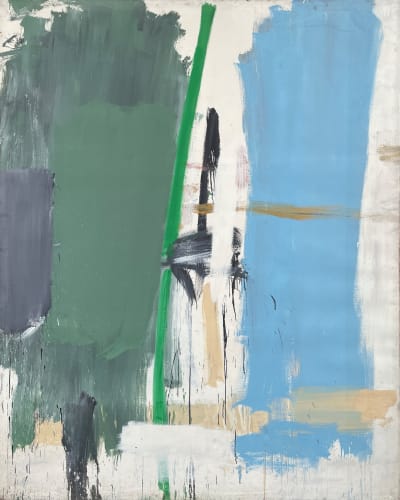When Lincoln Glenn partners Douglas Gold and Eli Sterngass opened the gallery last year, the mission was to “champion artists who have been overlooked over time,” says Gold. “As art dealers, we were collecting these artists but the market has sort of left them behind.”
The gallery has stayed on course with their mission by featuring a spectacular exhibition of six large-scale, monumental works by Alan Fenton (1927-2000)—widely recognized for his abstract or “nonobjective” paintings and drawings from the abstract expressionist movement in the 50s and 60s, but has somehow faded into obscurity.
The exhibition planning began with Gold’s personal interest in the artist and as a collector of his work. After reaching out to Fenton’s family estate, the gallery soon realized “we were fortunate to find these works…,” Gold says. “These pieces haven’t been exhibited for nearly 60 years, and due to their size, Fenton didn’t mean to really show them. We wanted to share with the public what hasn’t been seen before and make a statement about what Fenton is capable of as an artist.”
Fenton is more well-known as a watercolorist, switching to the medium later in his career, but this exhibition of oil paintings is “really special about who he was in scale and quality,” explains Gold. “These works were a little more unusual than the standard of what was being produced at this time. So many artists of this movement didn’t have the financial means to make large-scale works, but because he was transitioning in his career, he was able to manage it.” Raised in Cleveland, Ohio, where he eventually retired, Fenton arrived in New York City at the “height of the art revolution of the 50s and 60s,” after a successful career in the graphic design business. He was heavily influenced by the abstract expressionism of his friends and teachers Mark Rothko, Adolph Gottlieb and Jack Tworkov.
Gold notes that many artists, including Fenton, would leave the city go to Springs, an East Hampton enclave. Several of the colorful abstracts in the exhibition titled Springs III, 1960 and Pond I, 1958, were inspired by his time spent in the area with the tight-knit artist community. Springs III was exhibited twice at the Cleveland Museum of Art in the 60s, “and that was probably the last time the work was shown,” says Gold.
Gold also draws attention to the artist’s technique that involved painting from the top of the canvas, “but he never intended the pieces to be viewed in any specific orientation,” he explains. “Every painting [in the series] has the same brush strokes from top to bottom but they can be hung [and presented] in different ways.”
Fenton has described his own work as “natural and human, hard and soft, large and small, heaven and earth…All this with the image of man, (my glow) forms a system to attain the sublime. All of these paradoxes form a triad that is the way of everything. The line is the ‘hard,’ the formless form and the imageless image is the ‘soft.’ They are inseparable, one cannot exist without the other.”
The exhibition will hang through May 6 at Lincoln Glenn Gallery in Larchmont, New York.
